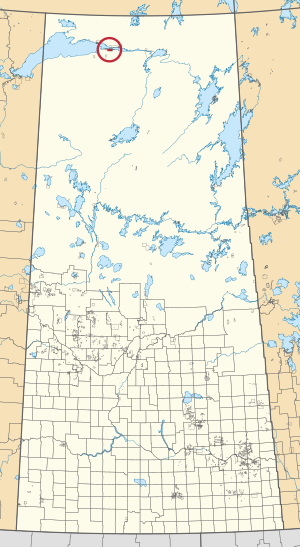Fond du Lac 233 facts for kids
Quick facts for kids
Fond du Lac 233
|
|
|---|---|
| Fond du Lac Indian Reserve No. 233 | |

Location in Saskatchewan
|
|
| First Nation | Fond du Lac |
| Country | Canada |
| Province | Saskatchewan |
| Area | |
| • Total | 8,341.5 ha (20,612.3 acre) |
Fond du Lac 233 is an Indian reserve located in the Canadian province of Saskatchewan. It is a special area of land set aside for the Fond du Lac Denesuline First Nation. This First Nation is one of many Indigenous groups in Canada.
Contents
Understanding Fond du Lac 233
Fond du Lac 233 is an important place for the Fond du Lac Denesuline First Nation. It is one of the lands they call home. This reserve helps preserve their culture and way of life.
Location and Size
Fond du Lac 233 is found in the northern part of Saskatchewan. It is a large area of land. The reserve covers about 8,341.5 hectares. To give you an idea, that's roughly the size of 15,000 football fields!
What is an Indian Reserve?
An Indian reserve is a piece of land in Canada. The Canadian government sets it aside for the use and benefit of a First Nations band. These lands are protected for Indigenous communities. They help First Nations keep their traditions alive. Reserves are not owned by individuals. Instead, they are held by the Crown for the band.
History of Reserves
The idea of reserves came from treaties signed long ago. These treaties were agreements between First Nations and the Canadian government. They often involved First Nations sharing their traditional lands. In return, they received certain rights and benefits. This included land for their communities.
Life on a Reserve
Life on a reserve can be very different from life in a city. Many reserves have their own schools and community centers. They also have local governments led by a chief and council. These leaders make decisions for their community. They work to improve life for everyone on the reserve.
The Fond du Lac Denesuline First Nation
The Fond du Lac Denesuline First Nation is the community connected to this reserve. They are part of the larger Dene family. The Dene are one of the oldest Indigenous groups in North America. They have lived in this region for thousands of years.
Dene Culture and Traditions
The Dene people have a rich culture. Their traditions include storytelling, drumming, and dancing. They also have strong connections to the land. Hunting, fishing, and trapping are important parts of their heritage. These activities help them connect with their ancestors. They also provide food and resources.
Language of the Dene
The traditional language of the Fond du Lac Denesuline is Dene Suline. This language is very important to their identity. Efforts are made to teach it to younger generations. This helps keep the language and culture strong.
Governance of the First Nation
The Fond du Lac Denesuline First Nation has its own government. This government is made up of a chief and council members. They are elected by the community. Their job is to manage the reserve's affairs. They also work to protect the rights of their people.
Importance of Indigenous Lands
Indigenous lands like Fond du Lac 233 are very important. They are places where culture, history, and traditions can thrive. They provide a base for communities to grow and develop. These lands help Indigenous peoples maintain their unique identities.
Protecting Heritage
Reserves help protect the heritage of First Nations. They are places where traditional knowledge can be passed down. Elders teach younger people about their history and customs. This ensures that their unique ways of life continue.
Future of Fond du Lac 233
The Fond du Lac Denesuline First Nation works towards a bright future. They focus on education, health, and economic growth. They aim to create strong, healthy communities. This helps their people thrive for generations to come.

